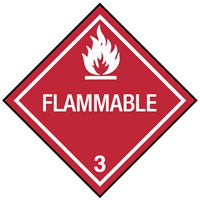
 Print
Print
Chemical Datasheet
PICOLINES |

|
Chemical Identifiers
| CAS Number |
UN/NA Number |
DOT Hazard Label |
USCG CHRIS Code |
|
|
|
|
|
| NIOSH Pocket Guide |
International Chem Safety Card |
|
none
|
none
|
NFPA 704
General Description
Clear colorless liquids with a strong unpleasant odor. Flash point 79 - 97°F. Less dense than water. Vapors heavier than air. Toxic oxides of nitrogen produced during the combustion of. Used as a solvent and to make other chemicals.
Hazards
Reactivity Alerts
Air & Water Reactions
Highly flammable. Soluble in water.
Fire Hazard
Special Hazards of Combustion Products: Emits toxic fumes under fire conditions. Forms explosive mixture in air. (USCG, 1999)
Health Hazard
Harmful if swallowed, inhaled or absorbed through the skin. Causes severe irritation. High concentrations are extremely destructive to tissues of the mucous membranes and upper respiratory tract, eyes and skin. Symptoms of exposure may include burning sensation, coughing, wheezing, laryngitis, shortness of breath, headache, nausea, vomiting and gastrointestinal disturbances. (USCG, 1999)
Reactivity Profile
PICOLINES neutralizes acids in exothermic reactions to form salts plus water. It is incompatible with isocyanates, halogenated organics, peroxides, phenols, sulfuric acid, epoxides, anhydrides, acid halides and iron (II) sulfate. Gamma picoline may generate hydrogen, a flammable gas, in combination with strong reducing agents such as hydrides. Dangerous fire hazard when exposed to heat, flame or oxidizers. Severe explosion hazards in the form of vapor, when exposed to flame or spark. Reacts violently with chlorosulfonic acid; CrO3; maleic anhydride; HNO3; oleum; perchromates; B-propiolactone; AgClO4; H2SO4;formamide; SO3; I. Dangerous when heated to decomposition it emits highly toxic fumes of cyanides; can react vigorously with oxidizing materials.
Belongs to the Following Reactive Group(s)
- Amines, Phosphines, and Pyridines
Potentially Incompatible Absorbents
Use caution: Liquids with this reactive group classification have been
known to react with the
absorbent
listed below.
- Mineral-Based & Clay-Based Absorbents
Response Recommendations
Isolation and Evacuation
Excerpt from ERG Guide 129 [Flammable Liquids (Water-Miscible / Noxious)]:
IMMEDIATE PRECAUTIONARY MEASURE: Isolate spill or leak area for at least 50 meters (150 feet) in all directions.
LARGE SPILL: Consider initial downwind evacuation for at least 300 meters (1000 feet).
FIRE: If tank, rail tank car or highway tank is involved in a fire, ISOLATE for 800 meters (1/2 mile) in all directions; also, consider initial evacuation for 800 meters (1/2 mile) in all directions. (ERG, 2024)
Firefighting
Excerpt from ERG Guide 129 [Flammable Liquids (Water-Miscible / Noxious)]:
CAUTION: The majority of these products have a very low flash point. Use of water spray when fighting fire may be inefficient.
SMALL FIRE: Dry chemical, CO2, water spray or alcohol-resistant foam. Do not use dry chemical extinguishers to control fires involving nitromethane (UN1261) or nitroethane (UN2842).
LARGE FIRE: Water spray, fog or alcohol-resistant foam. Avoid aiming straight or solid streams directly onto the product. If it can be done safely, move undamaged containers away from the area around the fire.
FIRE INVOLVING TANKS, RAIL TANK CARS OR HIGHWAY TANKS: Fight fire from maximum distance or use unmanned master stream devices or monitor nozzles. Cool containers with flooding quantities of water until well after fire is out. Withdraw immediately in case of rising sound from venting safety devices or discoloration of tank. ALWAYS stay away from tanks in direct contact with flames. For massive fire, use unmanned master stream devices or monitor nozzles; if this is impossible, withdraw from area and let fire burn. (ERG, 2024)
Non-Fire Response
Excerpt from ERG Guide 129 [Flammable Liquids (Water-Miscible / Noxious)]:
ELIMINATE all ignition sources (no smoking, flares, sparks or flames) from immediate area. All equipment used when handling the product must be grounded. Do not touch or walk through spilled material. Stop leak if you can do it without risk. Prevent entry into waterways, sewers, basements or confined areas. A vapor-suppressing foam may be used to reduce vapors. Absorb or cover with dry earth, sand or other non-combustible material and transfer to containers. Use clean, non-sparking tools to collect absorbed material.
LARGE SPILL: Dike far ahead of liquid spill for later disposal. Water spray may reduce vapor, but may not prevent ignition in closed spaces. (ERG, 2024)
Protective Clothing
Wear self-contained breathing apparatus, rubber boots, heavy rubber gloves, and protective clothing. (USCG, 1999)
DuPont Tychem® Suit Fabrics
No information available.
First Aid
INHALATION: CALL FOR MEDICAL AID. Remove victim to fresh air. If not breathing, give artificial respiration. If breathing is difficult, give oxygen.
EYES: Flush with copious amounts of water for at least 15 minutes. Assure adequate flushing of the eyes by separating eyelids with fingers.
SKIN: Flush with copious amounts of water for at least 15 minutes while removing contaminated clothing and shoes. (USCG, 1999)
Physical Properties
Flash Point:
134°F
(USCG, 1999)
Lower Explosive Limit (LEL): data unavailable
Upper Explosive Limit (UEL): data unavailable
Autoignition Temperature:
1000°F
(USCG, 1999)
Melting Point:
36.3°F
(USCG, 1999)
Vapor Pressure: data unavailable
Vapor Density (Relative to Air): data unavailable
Specific Gravity:
0.957
(USCG, 1999)
- Less dense than water; will float
Boiling Point:
293°F
at 760 mmHg
(USCG, 1999)
Molecular Weight:
93.13
(USCG, 1999)
Water Solubility: data unavailable
Ionization Energy/Potential: data unavailable
IDLH: data unavailable
AEGLs (Acute Exposure Guideline Levels)
No AEGL information available.
ERPGs (Emergency Response Planning Guidelines)
No ERPG information available.
PACs (Protective Action Criteria)
No PAC information available.
Regulatory Information
EPA Consolidated List of Lists
No regulatory information available.
CISA Chemical Facility Anti-Terrorism Standards (CFATS)
No regulatory information available.
OSHA Process Safety Management (PSM) Standard List
No regulatory information available.
Alternate Chemical Names
- GAMMA-PICOLINE
- METHYLPYRIDINE
- 4-METHYLPYRIDINE
- P-PICOLINE
- PICOLINE
- PICOLINE, [COMBUSTIBLE LIQUID LABEL]
- 4-PICOLINE
- PICOLINES


 Print
Print
